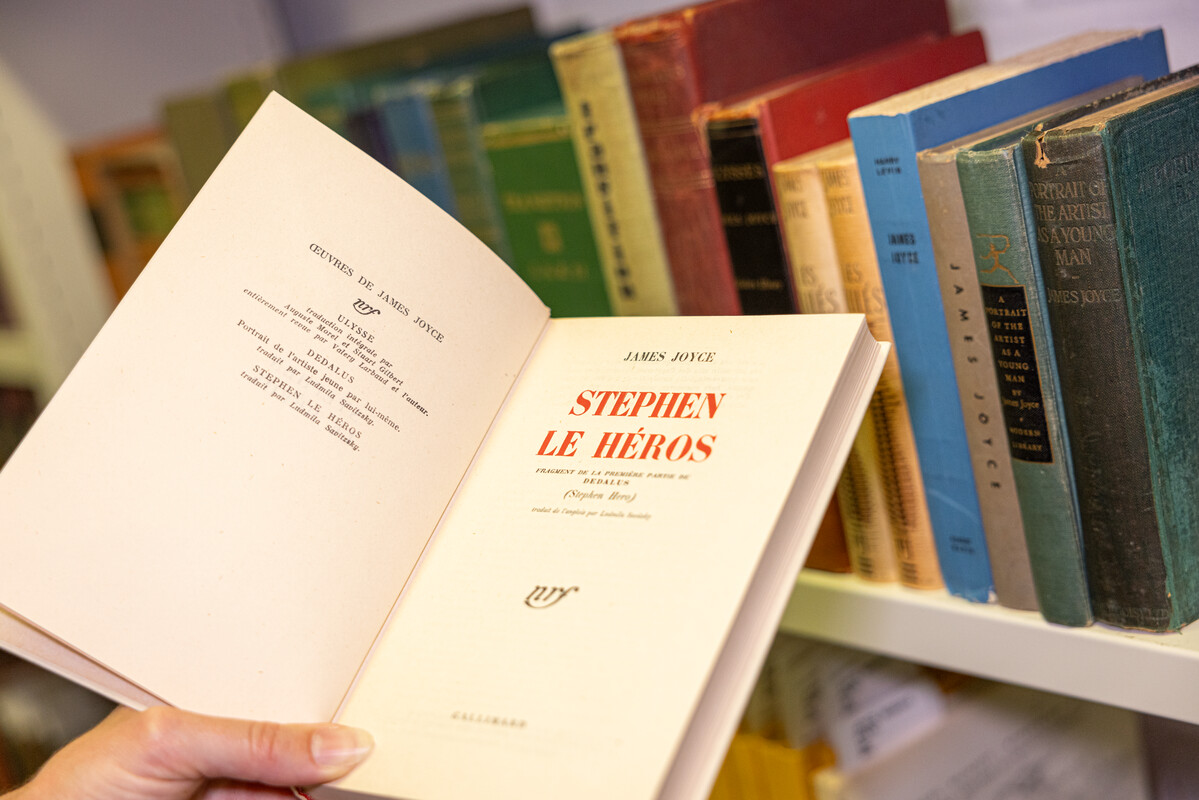JAMES JOYCE: A LOVE OF LANGUAGE EXHIBITION

The Solange and Stephen James Joyce Collection was bequeathed to the University of Reading in 2020. To coincide with the opening of James Joyce’s library of books and objects for public access, the Special Collections team have created a display to celebrate James Joyce’s love of language.
This first exhibition of items from the Solange and Stephen James Joyce Collection uses translations of James Joyce’s work to explore his place as a European and a citizen of the world. The exhibition opens on the European Day of Languages, 26th September 2023, and closes on Joyce’s birthday, 2nd February 2024.
JOYCE AS EUROPEAN
James Joyce and his future wife, Nora Barnacle, left Dublin in 1904 and lived in Austria-Hungary, Italy, Switzerland and France.
Joyce was interested in other European cultures and languages from an early age. In 1900, when he was just nineteen years old, he published an article on the Norwegian writer Henrik Ibsen.1 His studies at University College Dublin included Italian and French, developing his skill in two languages that would become an integral part of his adult life.
Joyce was insistent on the need to understand Ireland and Irish culture within a European context, writing to a publisher that Dublin “has been a capital [city] of Europe for thousands of years”.2 The connections between Ireland and continental Europe were a repeated theme in his work.
JOYCE AND TRANSLATION
Joyce was a translator himself, he became fluent in several languages and proficient in many more, including English, French, Italian, Triestine dialect, Latin, Norwegian, Russian, Danish, German, Greek and Spanish.
The open access library contains works by Joyce translated into nearly 30 languages, which is reflected in the exhibit. He took a keen interest in the translation of his work and worked closely with translators to express his own unique vocabulary. In Finnegans Wake Joyce created his own words, drawing on other languages, mythology, history and religion. Samuel Beckett was a close friend and worked on translating Anna Livia Plurabelle, a fragment of “Work in Progress”, into French with Joyce and others. It was published in 1931 in the Nouvelle Revue Française and a copy is on display.3
THE SOLANGE AND STEPHEN JAMES JOYCE COLLECTION

Stephen James Joyce, Joyce’s only grandchild, was born in France in 1932 to Joyce’s son, Giorgio, and his wife, Helen (née Kastor).
The Solange and Stephen James Joyce Collection was bequeathed to the University of Reading Special Collections in 2020. Stephen Joyce considered the “strong and important” connection between his grandfather and Samuel Beckett as a factor in considering the University as a suitable recipient, feeling that the co-location of the two collections would “considerably enhance” both.
This first display celebrates the library of books and objects from the collection, which are being made available for public access via the Reading Room. There are about 500 published editions of Joyce’s work, alongside 250 volumes of criticism and biography, extensive journals and 130 rare books, including first editions of Joyce’s works.
Objects in the collection are personal items belonging to the family, including jewellery and items commemorating Joyce. On display are one of Joyce’s pens and his death mask.
The University of Reading Special Collections team is currently cataloguing James Joyce’s personal archive of correspondence, manuscripts, press cuttings, photos, artwork and ephemera and updates will be available on the Special Collections’ website.
James Joyce: A love of language
View the exhibition: 26 September 2023 – 2 February 2024
Venue: The Museum of English Rural Life, Redlands Road, Reading, Berkshire, RG1 5EX, United Kingdom
The exhibition is available to view within The MERL opening hours:
Tuesday to Friday, 9am to 5pm
Saturday and Sunday, 10am to 5pm
Closed on Mondays (including Bank Holidays)
More information
Read more about the James Joyce: A love of language exhibition on our What’s On guide.
More information on the Solange and Stephen James Joyce Collection is available on our Collections A-Z pages.
Footnotes
1. Joyce, ‘Ibsen’s New Drama’, The Fortnightly Review (April 1, 1900), pp.575-590.
2. Letter from Joyce to Grant Richards, October 15, 1905. Letters of James Joyce, Vol.II, ed. Richard Ellmann, p.122.
3. Joyce, ‘Anna Livia Plurabelle’, trans. Samuel Beckett, Alfred Péron, et al, La Nouvelle Revue Française (1 May 1931), pp.633-646.
Image at top: James Joyce’s Parker fountain pen with Cartier gold book charm of Finnegans Wake, SSJ-OBJ/002